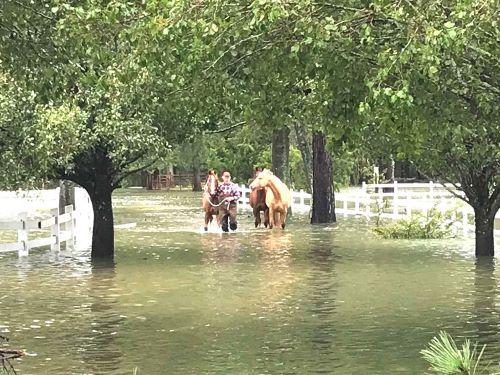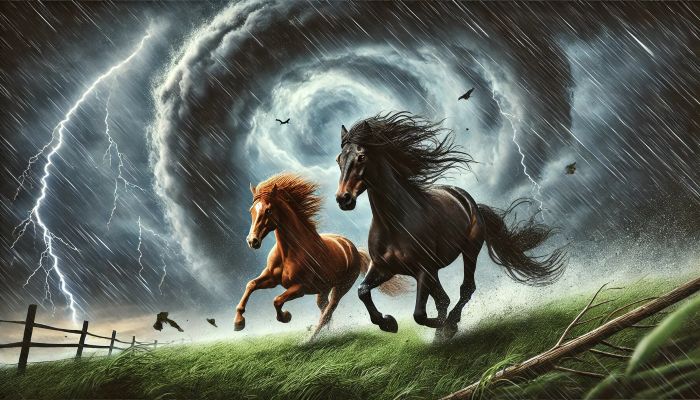Last Updated on February 21, 2025 by Teri Rehkopf
Hurricanes can be a real nightmare, especially when a beloved horse is involved. The hurricane’s powerful winds and heavy rainfall create challenging conditions that can severely affect livestock and facilities. It’s crucial to know what’s at stake.
I’ve been through a few hurricanes myself. It takes a lot of planning and work to coordinate care of your horse, whether you home-board your horse or board it elsewhere. From a teenager on up to my retirement years, I’ve dealt with disaster planning with my animals.
On a physical level, these storms can cause direct injuries from flying debris or structural damage to stalls and paddocks. But it’s not just the body that’s at risk; hurricanes can wreak havoc on a horse’s mental well-being, too. They can be easily spooked by loud noises and sudden changes in their environment, leading to increased anxiety and potential behavioral issues.
Related: Horses in Disasters Series – Real-Life Survival Stories
Preparing your horse well before a hurricane strikes isn’t just throwing up a few loose boards. It’s about comprehensive planning to reduce stress and prevent harm. This proactive approach can make all the difference in their physical safety and emotional stability when the skies turn gray.
Preparing Your Horse’s Environment
Securing your horse’s environment should top the list when preparing for hurricane season. A strong wind gust can quickly turn a friendly barn into a hazardous space, so ensuring everything’s nailed down and stable is key.
When we moved from my original homestead to another place with 5 acres and in the country, I had a barn built to withstand 150 mph winds. At the time, that was the maximum strength of hurricane winds. They’ve now gotten stronger to 175 mph and more.
First, ensure your barns and stables are in top shape to handle some rough weather. Check for any loose boards or roofs that might lift if the wind picks up. Reinforce anything that looks shaky. It might help to have some plywood handy to board up windows and doors as needed.
Read this: 17 Pioneer Skills We Should Learn
A safe pasture plan is also part of the strategy. If evacuation isn’t on the cards, having a secure and familiar pasture can be safer than confining them in barns. Pick a field that’s on higher ground to avoid flooding, away from potential falling trees or power lines.
Another consideration is ensuring you have enough supplies like:
- food,
- hay,
- water,
- and any necessary medications stocked before the storm hits.
Supply chains can be disrupted in hurricane-prone areas, so it’s smart to have what you need ahead of time.
If the usual water sources go offline, consider a reliable one. We always had a pool as a backup water supply.

Creating an Evacuation Plan
Having a solid evacuation plan is crucial for horse owners during hurricane threats. You can’t just roll up a map and hit the road; there’s a lot to think about when moving such large and sensitive creatures along with you.
Related: 8 Tips to Safely Evacuate Your Horse in a Disaster
The first step is knowing where you’re headed. Scout out potential evacuation spots well in advance. Whether it’s a friend’s farm on higher ground or a dedicated evacuation facility, knowing your destination reduces panic when a storm is looming.
It’s not just about the endpoint. You also need to plan your journey. Consider the best routes to take, avoiding those prone to flooding or heavy traffic. Map out alternatives in case primary roads are blocked.
Don’t forget the transport logistics. Your trailer needs to be in tip-top shape. Regular maintenance checks of the:
- brakes,
- tires,
- and lights ensure you’re not facing issues on the road.
It’s one less headache when time is of the essence.
Safety checks, while often overlooked, are vital. Ensure each horse has adequate space, ventilation, and secure footing in trailers. Practicing loading and unloading when the weather is calm can also ease the process during an evacuation.
Equipping Your Horse with Identification
When preparing for hurricanes, you must ensure your horse can be easily identified if it gets separated from you. This sounds like a basic step, but it’s one that’s often overlooked in the rush to get everything else ready.
Read this: Preparing Your Pet For Emergencies As A Senior Citizen
Start by equipping each horse with a reliable identification method. Microchipping is highly recommended due to its permanence and the ease with which horses can be tracked. However, traditional methods like ID tags on halters or braided into manes can work well if microchipping isn’t available.
Updating identification cards with recent photos and vital information, like any specific markings or health needs, helps in their recovery. Keep copies folded neatly in a waterproof sleeve and accessible during an evacuation.
Stories abound of reunited owners and horses after hurricanes, thanks to proper identification. It’s a bit of planning that can quickly pay off, bringing peace of mind knowing you have a plan to get back your horse if you get separated.
Training Your Horse for Emergency Situations
Training horses for emergencies is a crucial part of preparation that can’t be ignored. Imagine dealing with a terrified horse in the chaos of a hurricane evacuation—definitely not ideal.
One key aspect of training involves getting your horse comfortable loading and unloading from trailers. Regular practice sessions can make the real thing smoother and less stressful for both of you. Horses should see this as routine, not a panic-driven task.
Even when things are hectic, teaching your horse to respond to basic commands and cues is worth its weight in gold. A calm, reassuring voice can often cut through anxiety if they’re used to listening and cooperating with you.
Read this: Solar Gear Worth Buying for Grid-Down Situations
Desensitization training can also help. Gradually introducing your horse to storm-like noises and then rewarding calm behavior can lessen their fear when the wind starts howling in earnest. Using recordings or simulations could be an excellent way to do this.
Proper preparation through training helps create trust in difficult situations and can lead to a safer experience for your horse when natural disasters strike.
People Also Ask: Common Questions
When hurricanes hit, many horse owners have asked what do I do next?
Knowing how to handle injuries, for example, is a big concern. If your horse gets hurt, the first move is to ensure a safe environment to prevent further harm, then contact a vet as soon as possible for professional advice.
Some horses might refuse to get onto a trailer during evacuation. What do I do then?
In moments like these, patience is key. Keeping calm and using positive reinforcement, like treats or familiar comforting cues, might encourage them to cooperate.
What kind of insurance coverage for hurricane damage for horses should I have?
Policies can vary greatly, so it’s a good idea to review yours well before storm season. Make sure it covers a wide range of better- and worse-case scenarios, including injury and property damage.
Being prepared for these situations can reduce stress and uncertainty when disaster strikes. Proper planning and knowing the answers to common concerns can help keep you and your horses safe through the hurricane season.
One of my biggest concerns was the trailer loading. My mare wasn’t good at loading in a trailer. She had been abused during a loading incident, and she always remembered that time. She loved food, so that was what I used to coax her onto the trailer. Don’t ever beat your horse to get it to load. They are bigger than you.
What do you think? Have you prepared for hurricanes and other disasters? Had you had to move your horse during a disaster? Did you have any issues/problems doing this process? Let me know in the comments section below. I’d love to hear your perspective/issues/concerns and I always reply.

